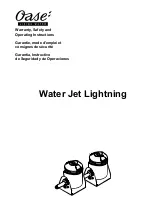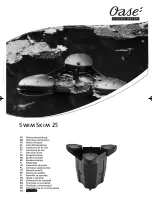
Page 6
WELDING and CUTTING SPARKS can cause
fire or explosion.
Expressweld MasterMIG 500W
Where compressed gases are to be used at the job site, special precautions should be
used to prevent hazardous situations.
Do not heat, cut or weld tanks, drums or containers until the proper steps have been
taken to insure that such procedures will not cause flammable or toxic vapors from
substances inside. Tanks, drums or containers can cause an explosion even though
they have been cleaned. For information, read Recommended Safe Practices for the
Preparation for Welding and Cutting of Containers and Piping That Have Held
Hazardous Substances , AWS F4.1 from American Welding Society.
Connect the work cable to the work as close to the welding area as possible. Work
cables connected to the building framework or other locations away from the welding
area increase the possibility of the welding current passing through lifting chains, crane
cables or other alternate circuits. This can create fire hazards or overheat lifting chains
or cables until they fail.
Keep away fire hazards from welding area and have a fire extinguisher readily
available. Remember that welding sparks and hot materials from welding can easily go
through small cracks and openings to adjacent areas. Until ensuring that precautions
are used to fully clean flammable and toxic gases, never weld any tanks, drums,
containers or material. Never operate welder in places that flammable gases, vapors or
liquid fuels exist.
Always keep in mind the fire risk due to high temperatures in arc welding. Welding arc
temperature may increase up to 5000 C, but generally this temperature is not the only
fire reason. Fire risk may be occurred due to sparks or melted metals splashed around.
These metals may splash up to ten meters away. Therefore keep inflammable materials
away from welding area. Also make sure that your work piece do not contact with any
material that may flare when heated. Material that may flare with contact are divided
into three categories as liquids (fuel, oil, paint, thinner etc.), solids (wood, cartoon,
paper etc.) and gases (acetylene, hydrogen etc.).
Inspect the welding area. If there are systems operating with fuel or hydraulic oil and if
you cannot move welding area or system, place fire-resistant protecting screen
between them.
“
”
°













































